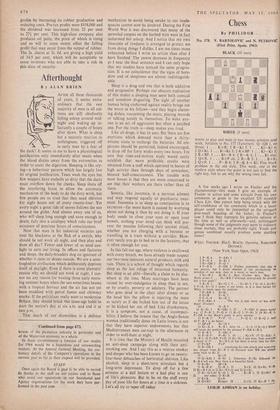Chess
By PHILIDOR No. 178. V. BARTOLOVIC and N. PETROVIC (First Prize, Spain, 1963)
BLACK (10 men)
WHITE (9 men)
WHITE to play and mate in two moves; solution next week. Solution to No. 177 (Taverner): Q—QB I, no threat. 1 . . . K X R; 2 R—Kt 5. 1 . . . Kt—Kt 4;
2 Qx Kt. 1 R—Kt 3; 2 R x BP. 1 ... Kt—Kt 3; 2 R x BP. 1 Kt—B 4; 2 R—K 6.1 ... Kt else; 2 QXR. I BXP ch; 2 R—B 5. 1 BXR;
2 Q X P. I . P—B 4; 2 P—K 8 = Kt. Fine block problem in the old style. This week, one in the modern style where the point is not just to find the right key, but to see why the wrong ones fail.
A few weeks ago I wrote on Fischer and the championship—this week I give an example of Fischer in action and some extracts from his own comments as given in the excellent US monthly Chess Life. One cannot help being struck with the self-confidence of the comments which in a lesser player could only be interpreted as the arrogant post-result boasting of the victor; in Fischer's case I think they represent his genuine opinion at the time as well as afterwards—and, extravagant though some of the judgments may seem to ordinary chess mortals, they are probably right. Youth and genius combined usually produce some startling views!
While, FISCHER; Black, BEACH; Opening, RosATscil
DEFENCE.
(New York State Open, 1963)
I P—K 4 P—KKt 3 2 P—Q 4 B—Kt 2 3 Kt--QB 3 P—Q 3 4 P—B 4 P—QB 3. Fischer comments that this ill too passive, but I doubt whether it can satisfactorily be avoided—if not now, then in a move or two's time. 5 Kt—B 3 B—Kt 5. Here Fischer says, 'Best for Black seems 5 .. . Kt—KB 3 although strategically he ahead)! has a lost game!
6 B—K 3 Kt—Q 2. 6. . . Q—Kt 3; 7 Q—Q 2, BXKt; 8 P xB, Kt—Q 2 seems to me better, as it is then hardtx. for White to break open the position.
7 P—KR 3 BxKl . 8 QXB P-1( 3 9 0-0-0 Kt—K 2
10 P—KKt 4 . 'The rest is just more or less tech- nique' (Fischer)
10 . . . Q—R 4
11 K—Kt 1 R—QKt I. 11 . . . P-0Kt 4: seems better e.g. 12 P—K 5. P—Q 4; 13 B—Q 3, P—Kt 5; 14 Kt—K 2. P—QB 4—but Black's game is poor anyway. "
12 P—K 5! P X P. 12 . . . P—Q 4; 13 B—Q 3 end 14 P—B 5 is no better.
13 QPxP Kt—Q 4 14 Kt—K 4 B—B I. After 14 ... 0-0; 15 B—Q 2 White will break the position by the advance P—KR 4—R 5,
15 B—B 1 P—QKt 4
16 P—B 5! P—Kt 5. 16 . . . Kt X P; 17 Q—KKt 3, Q—B 2; 18 PXKP, PXP; 19 Kt—Kt 5 and wins. Text contains
a threat of 17 Kt—B 6 ch but there is never time for this.
17 PxKP P x P 18 B—QB 4 continuing his own attack and removinll any danger from Kt—fl 6 eh (because now WB atm alwaYs come back to Kt 3).
18 ... KtxP 19 Q—KKt 3 B—Kt 2. Otherwise BxKt followed blf B—B 4 will win. Now there is a beautiful finish.
20 BXKt BP X B
21 B—R 6! Q—B 2. 21 . • . B B. 22 QxKt, 0-0; 23 Kt—B 6 ch or 22 Kt—B 6 ch and 23 Q X Kt. 22 Kt—Q 6 ch! K—Q 1. 22 . . . K—B 1; 23 QxKt! 22 . . any other; 23 BXB.
23 BXB QXB • 24 QXKt! Resigns. 24 . . QXQ; 25 Kt—B 7 ch.
' (A) r / /. % A
V /
A ,/4






























 Previous page
Previous page